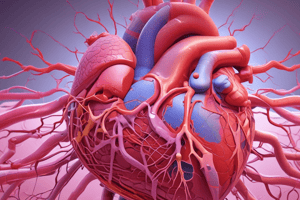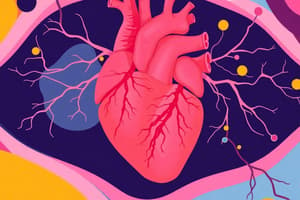Podcast
Questions and Answers
What is the primary function of the circulatory system?
What is the primary function of the circulatory system?
- To regulate body temperature
- To pump and direct blood cells and substances to all tissues (correct)
- To produce hormones
- To filter waste from the blood
Which chamber of the heart primarily receives blood from the pulmonary veins?
Which chamber of the heart primarily receives blood from the pulmonary veins?
- Left ventricle
- Left atrium (correct)
- Right atrium
- Right ventricle
Which layer of the heart wall is the thickest?
Which layer of the heart wall is the thickest?
- Endocardium
- Myocardium (correct)
- Subendocardial layer
- Epicardium
What type of tissue primarily makes up the endocardium?
What type of tissue primarily makes up the endocardium?
What is the role of the subendocardial layer?
What is the role of the subendocardial layer?
Where does the epicardium correspond in relation to the heart's membranes?
Where does the epicardium correspond in relation to the heart's membranes?
Which chamber of the heart propels blood to the pulmonary circulation?
Which chamber of the heart propels blood to the pulmonary circulation?
What type of muscle is predominantly found in the myocardium?
What type of muscle is predominantly found in the myocardium?
What role does adipose tissue in the epicardium play during heart movements?
What role does adipose tissue in the epicardium play during heart movements?
Which structure forms part of the interventricular and interatrial septa?
Which structure forms part of the interventricular and interatrial septa?
What is the function of the dense irregular connective tissue in the heart?
What is the function of the dense irregular connective tissue in the heart?
What is the primary function of the sinoatrial (SA) node?
What is the primary function of the sinoatrial (SA) node?
Which of the following accurately describes the composition of blood vessel walls?
Which of the following accurately describes the composition of blood vessel walls?
How do vascular endothelial cells align in relation to blood flow?
How do vascular endothelial cells align in relation to blood flow?
What characterizes the specialized myocardial cells of the impulse conducting system?
What characterizes the specialized myocardial cells of the impulse conducting system?
What is the key role of the AV bundle (of His) in the heart's conduction system?
What is the key role of the AV bundle (of His) in the heart's conduction system?
Flashcards
Circulatory system
Circulatory system
The circulatory system carries blood cells and nutrients to all body tissues. This system includes both the blood and lymphatic vascular systems, with a total vessel length estimated between 100,000 and 150,000 kilometers in adults.
Cardiovascular system
Cardiovascular system
The cardiovascular system is responsible for pumping and circulating blood throughout the body. It includes the heart, arteries, capillaries, and veins.
What is the heart?
What is the heart?
The heart is a muscular organ that rhythmically contracts to pump blood through the circulatory system. It has four chambers: right and left ventricles and right and left atria.
Ventricles' role
Ventricles' role
Signup and view all the flashcards
Atria's role
Atria's role
Signup and view all the flashcards
Endocardium
Endocardium
Signup and view all the flashcards
Myocardium
Myocardium
Signup and view all the flashcards
Epicardium
Epicardium
Signup and view all the flashcards
Cardiac Skeleton
Cardiac Skeleton
Signup and view all the flashcards
Subendocardial layer
Subendocardial layer
Signup and view all the flashcards
Sinoatrial (SA) node
Sinoatrial (SA) node
Signup and view all the flashcards
Atrioventricular (AV) node
Atrioventricular (AV) node
Signup and view all the flashcards
AV bundle (Bundle of His)
AV bundle (Bundle of His)
Signup and view all the flashcards
Subendocardial conducting network
Subendocardial conducting network
Signup and view all the flashcards
Purkinje Fibers
Purkinje Fibers
Signup and view all the flashcards
Endothelium
Endothelium
Signup and view all the flashcards
Study Notes
Cardiovascular System Histology (Part 1)
- The circulatory system carries blood and substances to all body tissues. The total length of blood vessels in an adult is estimated at 100,000 to 150,000 km.
- The cardiovascular system includes the blood vascular system.
- The blood vascular system consists of: heart, arteries, capillaries, and veins.
Heart Structure and Function
- The heart's four chambers (right and left ventricles, right and left atria) contract rhythmically, pumping blood through the pulmonary and systemic circulation.
- The right ventricle pumps blood to the pulmonary circulation, while the left ventricle pumps blood to the systemic circulation.
- The right and left atria receive blood from the body and pulmonary veins, respectively.
Heart Wall Layers
- The heart wall consists of three layers:
- Endocardium: a thin inner layer of endothelium and connective tissue. Includes the heart's impulse-conducting system.
- Myocardium: a thick layer of cardiac muscle, arranged spirally around the heart chambers. It's thicker in the ventricle walls (especially left). This is needed for the strong pumping action.
- Epicardium: a simple squamous mesothelium (a thin layer of cells) supported by connective tissue. This layer corresponds to the visceral pericardium. This cushions the heart and prevents friction.
Additional Heart Structures
- The heart also includes dense fibrous connective tissue forming parts of the interventricular and interatrial septa, as well as surrounding the heart valves. This tissue anchors the valves and acts as electrical insulation.
- Sinoatrial (SA) node: The pacemaker located in the right atrium.
- Atrioventricular (AV) node,
- AV bundle (of His),
- Subendocardial conducting network (Purkinje fibers): These cells conduct electrical impulses that cause the heart to contract.
Vascular Wall Tissues
- Blood vessel walls (excluding capillaries) have endothelial linings with smooth muscle and connective tissue.
- The amount and arrangement of these tissues depend on factors like blood pressure and metabolic needs.
- Endothelium acts as a semipermeable barrier between blood plasma and interstitial tissue fluid.
- Vascular endothelial cells are polygonal and elongated, with their axis aligned with blood flow.
- Smooth muscle is present in vessel walls larger than capillaries and are arranged helically. This helps regulate blood pressure.
- Connective tissue components, including collagen and elastic fibers, provide structure and resilience to the vessel walls. Elastic tissue is more prominent in large arteries.
Studying That Suits You
Use AI to generate personalized quizzes and flashcards to suit your learning preferences.




